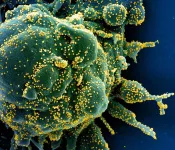(Press-News.org) WHAT:
Mice administered raw milk samples from dairy cows infected with H5N1 influenza experienced high virus levels in their respiratory organs and lower virus levels in other vital organs, according to findings published in the New England Journal of Medicine. The results suggest that consumption of raw milk by animals poses a risk for H5N1 infection and raises questions about its potential risk in humans.
Since 2003, H5N1 influenza viruses have circulated in 23 countries, primarily affecting wild birds and poultry with about 900 human cases, primarily among people who have had close contact with infected birds. In the past few years, however, a highly pathogenic avian influenza virus called HPAI H5N1 has spread to infect more than 50 animal species, and in late March, the United States reported a viral outbreak among dairy cows in Texas. To date, 52 cattle herds across nine states have been affected, with two human infections detected in farm workers with conjunctivitis. Although the virus has so far shown no genetic evidence of acquiring the ability to spread from person-to-person, public health officials are closely monitoring the dairy cow situation as part of overarching pandemic preparedness efforts.
To assess the risk of H5N1 infection by consuming raw milk, researchers from the University of Wisconsin-Madison and Texas A&M Veterinary Medical Diagnostic Laboratory fed droplets of raw milk from infected dairy cattle to five mice. The animals demonstrated signs of illness, including lethargy, on day 1 and were euthanized on day 4 to determine organ virus levels. The researchers discovered high levels of virus in the animals’ nasal passages, trachea and lungs and moderate-to-low virus levels in other organs, consistent with H5N1 infections found in other mammals.
In addition to the mice studies, the researchers also tested to determine which temperatures and time intervals inactivate H5N1 virus in raw milk from dairy cows. Four milk samples with confirmed high H5N1 levels were tested at 63 degrees Celsius (145.4 degrees Fahrenheit) for 5, 10, 20 and 30 minutes, or at 72 degrees Celsius (161.6 degrees Fahrenheit) for 5, 10, 15, 20 and/or 30 seconds. Each of the time intervals at 63℃ successfully killed the virus. At 72℃, virus levels were diminished but not completely inactivated after 15 and 20 seconds. The authors emphasize, however, that their laboratory study was not identical to large-scale industrial pasteurization of raw milk and reflect experimental conditions that should be replicated with direct measurement of infected milk in commercial pasteurization equipment.
In a separate experiment, the researchers stored raw milk infected with H5N1 at 4℃ (39.2 degrees Fahrenheit) for five weeks and found only a small decline in virus levels, suggesting that the virus in raw milk may remain infectious when maintained at refrigerated temperatures.
To date, the U.S. Food and Drug Administration concludes that the totality of evidence continues to indicate that the commercial milk supply is safe. While laboratory benchtop studies provide important, useful information, there are limitations that challenge inferences to real world commercial processing and pasteurization. The FDA conducted an initial survey of 297 retail dairy products collected at retail locations in 17 states and represented products produced at 132 processing locations in 38 states. All of the samples were found to be negative for viable virus. These results underscore the opportunity to conduct additional studies that closely replicate real world conditions. FDA, in partnership with USDA, is conducting pasteurization validation studies – including the use of a homogenizer and continuous flow pasteurizer. Additional results will be made available as soon as they are available.
The National Institute of Allergy and Infectious Diseases, part of the National Institutes of Health, funded the work of the University of Wisconsin-Madison researchers.
ARTICLE:
G Lizheng et al. Cow Milk Containing H5N1 Influenza Viruses—Heat Inactivation and Infectivity in Mice. The New England Journal of Medicine DOI: 10.1056/NEJMc2405495 (2024).
WHO:
NIAID Director Jeanne Marrazzo, M.D., and Lauren Byrd-Leotis, Ph.D., with NIAID’s Division of Microbiology and Infectious Diseases’ Viral Respiratory Diseases Section, are available to discuss the findings.
CONTACT:
To schedule interviews, please contact Kathy Donbeck, (301) 402-1663, niaidnews@niaid.nih.gov.
NIAID conducts and supports research—at NIH, throughout the United States, and worldwide—to study the causes of infectious and immune-mediated diseases, and to develop better means of preventing, diagnosing and treating these illnesses. News releases, fact sheets and other NIAID-related materials are available on the NIAID website.
About the National Institutes of Health (NIH): NIH, the nation's medical research agency, includes 27 Institutes and Centers and is a component of the U.S. Department of Health and Human Services. NIH is the primary federal agency conducting and supporting basic, clinical, and translational medical research, and is investigating the causes, treatments, and cures for both common and rare diseases. For more information about NIH and its programs, visit http://www.nih.gov/.
NIH...Turning Discovery Into Health®
END
Researchers at the U of A found self-identified small business owners on TikTok are circumventing a number of local, state and federal laws that restrict the individual sale of tobacco products. Specifically, the researchers found that 45% of the videos highlighted the fact that they did not require identification to verify the purchaser’s age.
“Many states have laws that govern procedures necessary to sell e-cigarettes,” explained lead researcher Page Dobbs, an associate professor of public health in the Department of Health, Human Performance and Recreation ...
Leading African scientists have issued a compelling call for more equitable research partnerships in a new paper published in Nature Medicine. The paper underscores the critical need for fair and collaborative research efforts to explore the unique and diverse microbiomes found in African populations and environments. Historically, these microbiomes have been underrepresented in global studies.
Over the past two decades, our understanding of the role played by the microbiome in different ecosystems has significantly expanded. For ...
LA JOLLA, CA—New research from scientists at La Jolla Institute for Immunology (LJI) suggests people who received COVID-19 vaccines and then experienced "breakthrough" infections are especially well armed against future SARS-CoV-2 infections.
By analyzing blood samples from study volunteers, the LJI researchers discovered that people who experienced symptomatic breakthrough infections develop T cells that are better at recognizing and targeting SARS-CoV-2, including the Omicron and Delta variants. The researchers describe this increased protection as an "immunity wall."
"The virus evolves, but, importantly, so does the immune system. T cells ...
May 24, 2024 --
A team of international scientists, including Virginia Tech entomologist Warren Booth, have solved the 250-year-old origin puzzle of the most prevalent indoor urban pest insect on the planet: the German cockroach.
The team's research findings, representing the genomic analyses of over 280 specimens from 17 countries and six continents, show that this species evolved some 2,100 years ago from an outside species in Asia and were released this week in the Proceedings of the National Academy of Sciences journal.
One ...
Get introduced to the latest advances in skin research at the 15th International Conference on Skin Ageing & Challenges 2024 on November 5-6 at Corinthia Palace in Malta.
Skin Ageing & Challenges 2024 will cover the hottest topics shaping the future of skin aging and rejuvenation.
How will Skin Ageing & Challenges 2024 Expand Your Knowledge?
Senolytics: Exploring new ways to fight cell aging with innovative senolytic treatments.
Extracellular Vesicles: Discovering the potential of EVs for skin regeneration and repair.
Skin Microbiota / Mitochondria Transplantation: Introducing approaches to harness the power of microbiome and mitochondrial transplantation ...
Carbon dioxide is the greenhouse gas, singlehandedly responsible for 78% of the change in energy balance in Earth's atmosphere between 1990 and 2022.
A byproduct of burning fossil fuels, carbon dioxide enters the atmosphere from car exhaust and coal-fired power plants. Even some renewable energy resources produce a small amount of carbon dioxide, although at a tiny fraction of the amount coal and natural gas create.
At its core, this molecule is just an arrangement of one carbon and two oxygen atoms that can be reorganized through a ...
New research from Memorial Sloan Kettering Cancer Center (MSK) investigates a promising approach against diabetic retinopathy and finds patients with early-onset colorectal cancer likely don’t need more frequent surveillance colonoscopies.
Anti-ceramide immunotherapy promising against diabetic retinopathy, animal studies suggest
Diabetic retinopathy is a condition that affects blood vessels in people with diabetes and can cause blindness. Now a new study from a team at MSK, Michigan State University, and the University of Oklahoma Health Sciences Center shows that diabetic retinopathy can be considered a “ceramidopathy” — which ...
FINDINGS
A new study led by a UCLA-VA collaborative team looking at the landscape of genomic alterations in more than 5,000 veterans with metastatic prostate cancer uncovered differences in the genomic makeup of cancer cells that were associated with race and ethnicity.
Although the team found that a similar set of cancer-related genes were altered in both non-Hispanic Black and non-Hispanic white veterans, the frequencies that these alterations were observed at varied significantly ...
FINDINGS
A study led by UCLA Health Jonsson Comprehensive Cancer Center researchers found that using a combination of experimental immunotherapy drugs with chemotherapy significantly improves progression-free survival and overall survival for patients with metastatic colorectal cancer who have previously undergone standard chemotherapy treatment when compared to those who received the targeted therapy regorafenib alone.
The median progression-free survival, which is the amount of time during and after treatment when the cancer does not worsen or progress, with the combination treatment was 6.2 months compared to 2.1 months for those ...
European space mission Euclid has released early scientific papers based on observations made by the space telescope, along with five new astronomical images of the Universe, as the project sets about unravelling the secrets of the cosmos.
The new images are part of Euclid’s Early Release Observations (EROs) and accompany the mission’s first scientific data and 10 forthcoming science papers. Their publication comes less than a year after the space telescope’s launch and some six months after it returned its first full-colour ...









